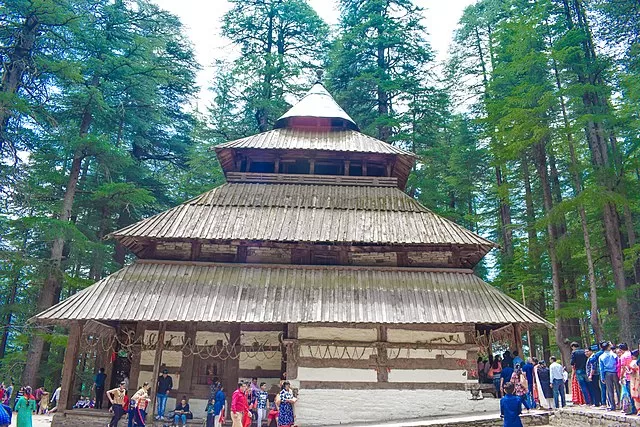Nestled amidst the picturesque landscape of Manali, the Hadimba Temple stands as a captivating testament to both architectural excellence and the local mythology. This sacred site holds a significant place in the hearts of both devotees and tourists, attracting them with its unique charm and historical importance. Let’s embark on a journey to uncover the mystique and grandeur of the Hadimba Temple.

Legend of Hadimba Temple
The temple’s origin traces back to the mythological tale of Hidimba, a rakshasi who fell in love with the Pandava prince Bhima. The temple stands on the very spot where Hidimba used to meditate, seeking penance for her brother’s defeat. This sacred ground thus commemorates her devotion and her eventual transformation into a deity.
Architectural Marvel

Crafted in the unique Pagoda style, the Hadimba Temple showcases intricate woodwork that is a testament to the craftsmanship of the local artisans. The temple’s wooden door panels, elaborate carvings, and the three-tiered roof stand as remarkable examples of traditional Himalayan architecture.
Spiritual Significance
Devotees flock to the temple to seek blessings from Goddess Hadimba, who is believed to bestow protection and strength. The serene atmosphere and the divine aura of the temple offer solace to those in search of spiritual rejuvenation.
Festivals and Celebrations

The temple comes alive during various festivals, with the most prominent being the Hadimba Devi Festival. The festivities include traditional dance, music, and colorful processions, providing visitors with a glimpse into the vibrant local culture.
Tranquil Surroundings
Surrounded by deodar forests and lush meadows, the temple offers a peaceful retreat from the hustle and bustle of everyday life. The fragrance of pine trees and the distant view of the Himalayan peaks create an ambiance of serenity.
Visitor Experience

Visitors are not only drawn to the temple for its religious significance but also for the sense of tranquility it offers. The temple’s location provides breathtaking panoramic views, making it a favorite spot for nature lovers and photographers.
Local Markets and Cuisine
Exploring the area around the temple offers a chance to experience the local way of life. The nearby markets showcase traditional handicrafts, woollen clothing, and local delicacies that tantalize the taste buds.
Exploring Nearby Attractions
The Hadimba Temple is also a gateway to nearby attractions like the Manu Temple, Vashisht Hot Springs, and the Solang Valley. Each destination offers a unique experience, ranging from spiritual immersion to adventurous escapades.
Photography Opportunities

For photography enthusiasts, the temple’s architecture against the backdrop of the stunning landscapes provides ample opportunities to capture captivating shots. The play of light and shadow on the intricate carvings adds depth to the visual narrative.
Sustainable Tourism Practices
The temple administration actively promotes sustainable tourism practices to preserve the ecological balance of the region. Visitors are encouraged to respect the environment and the local culture while enjoying their visit.
Preserving Cultural Heritage
The Hadimba Temple stands as a symbol of the region’s rich cultural heritage. Efforts are underway to ensure the preservation of this heritage, allowing future generations to connect with their roots.
How to Reach
The temple is easily accessible from Manali town, and visitors can opt for local transportation or even enjoy a leisurely walk through the scenic trails.
Best Time to Visit
The temple is open throughout the year, but the best time to visit is during the summer and autumn months when the weather is pleasant, and the surrounding landscapes are at their vibrant best.
Conclusion
In the heart of the Himalayas, the Hadimba Temple stands as a bridge between mythology and spirituality, offering a unique blend of devotion and natural beauty. As you stand before its intricately carved walls, you can’t help but feel a sense of reverence for the history and spirituality it embodies.
FAQs
- Is photography allowed within the temple premises?
Yes, photography is allowed, and the temple’s architecture provides excellent opportunities for stunning photographs. - Are there any accommodations available near the temple?
Yes, there are various hotels and guesthouses in the vicinity catering to different budgets. - Can I participate in the local festivals as a visitor?
Absolutely, the local festivals are open to visitors, and it’s a great way to immerse yourself in the vibrant culture. - Are there any trekking trails around the temple?
Yes, there are trekking routes that lead to nearby attractions, allowing you to explore the natural beauty of the region. - What is the significance of the Pagoda style of architecture?
The Pagoda style is a distinct architectural form that originated in East Asia and is characterized by its multi-tiered, curved eaves, resembling an elegant tower.

